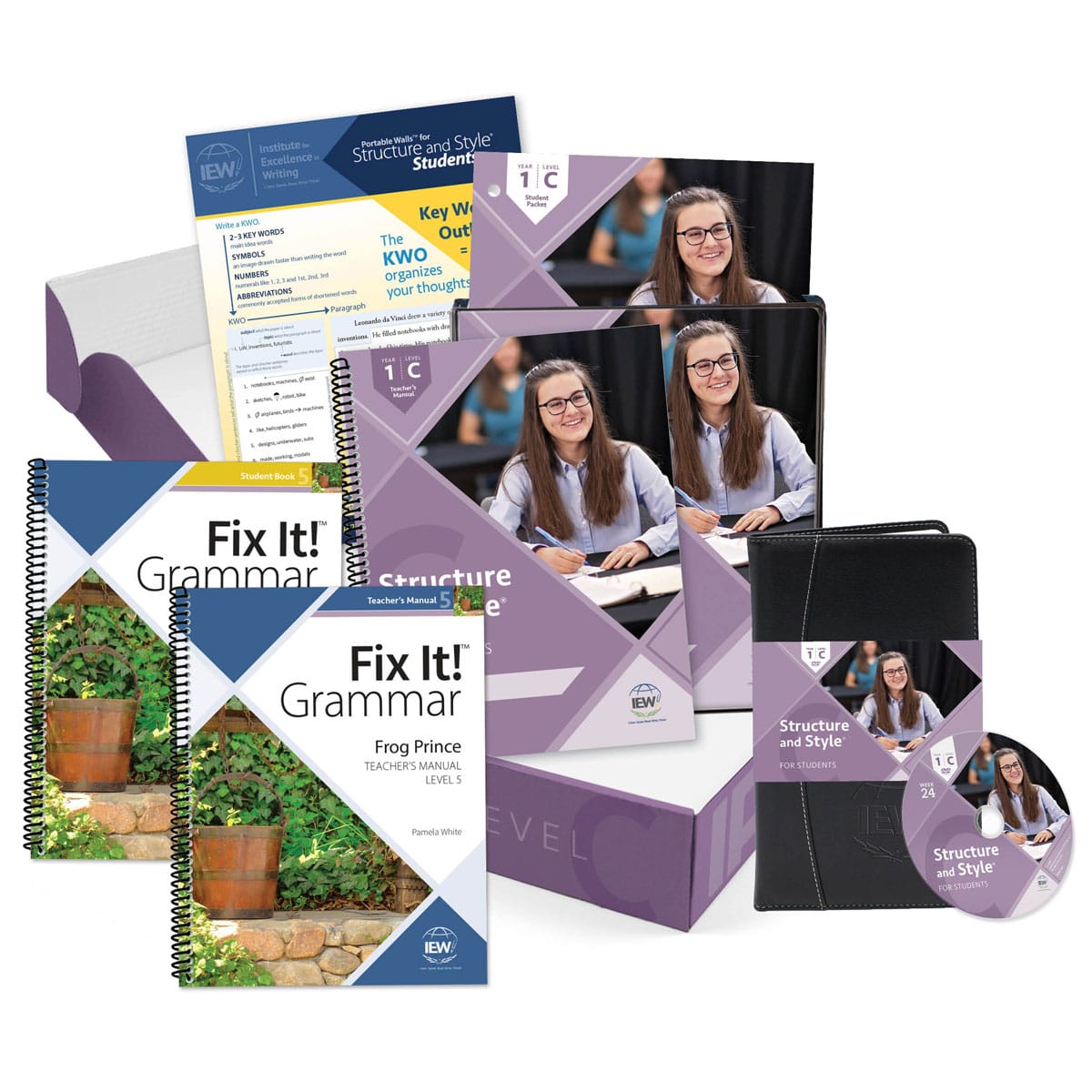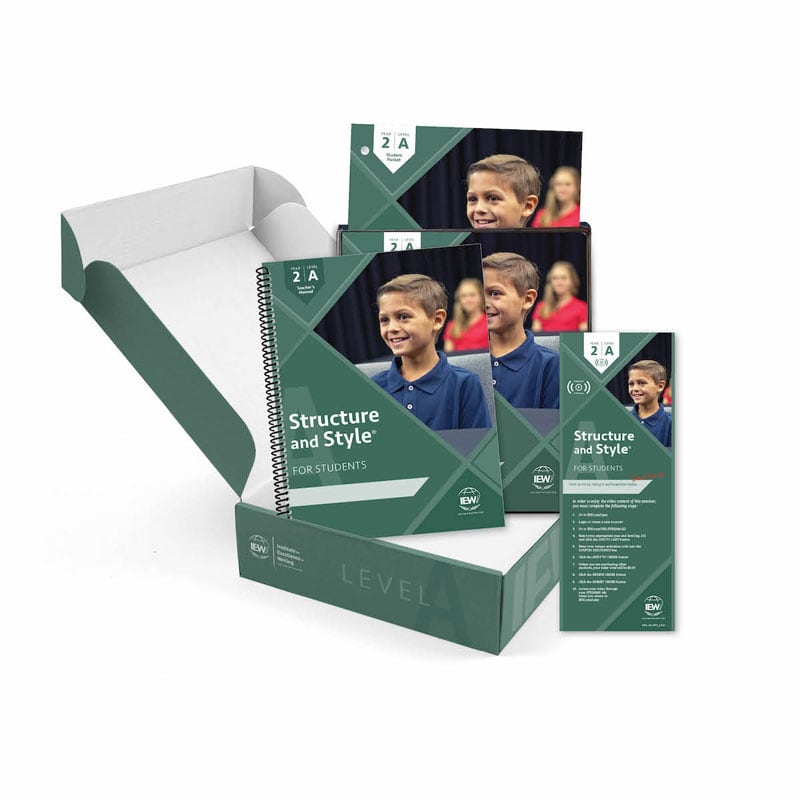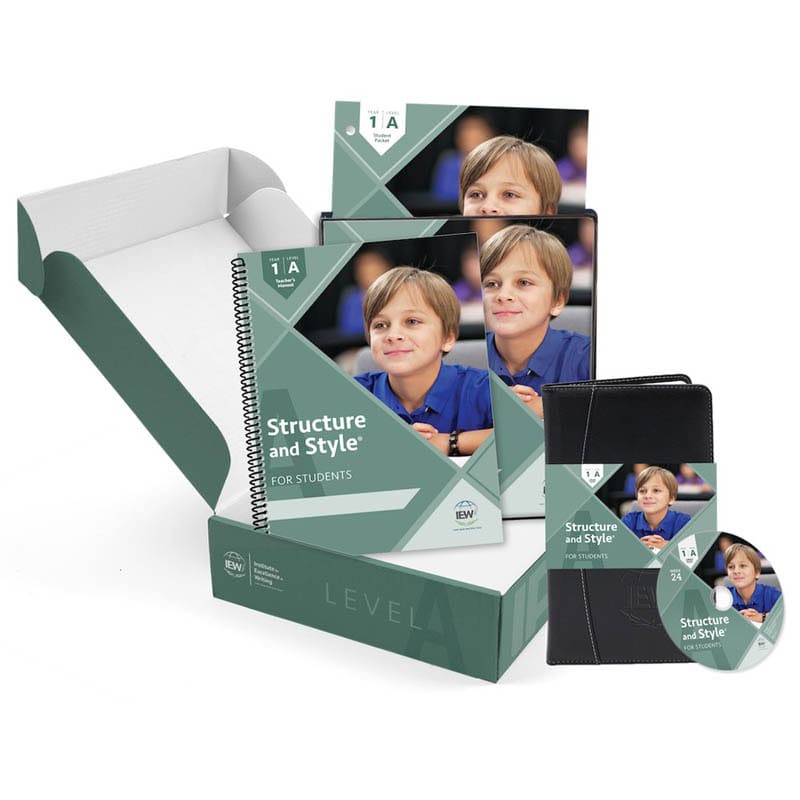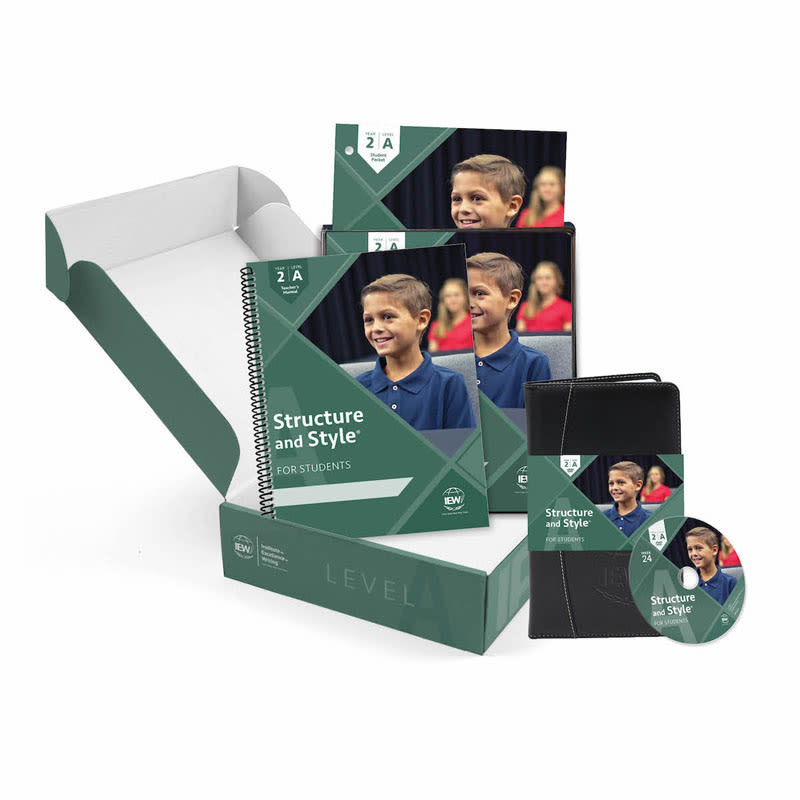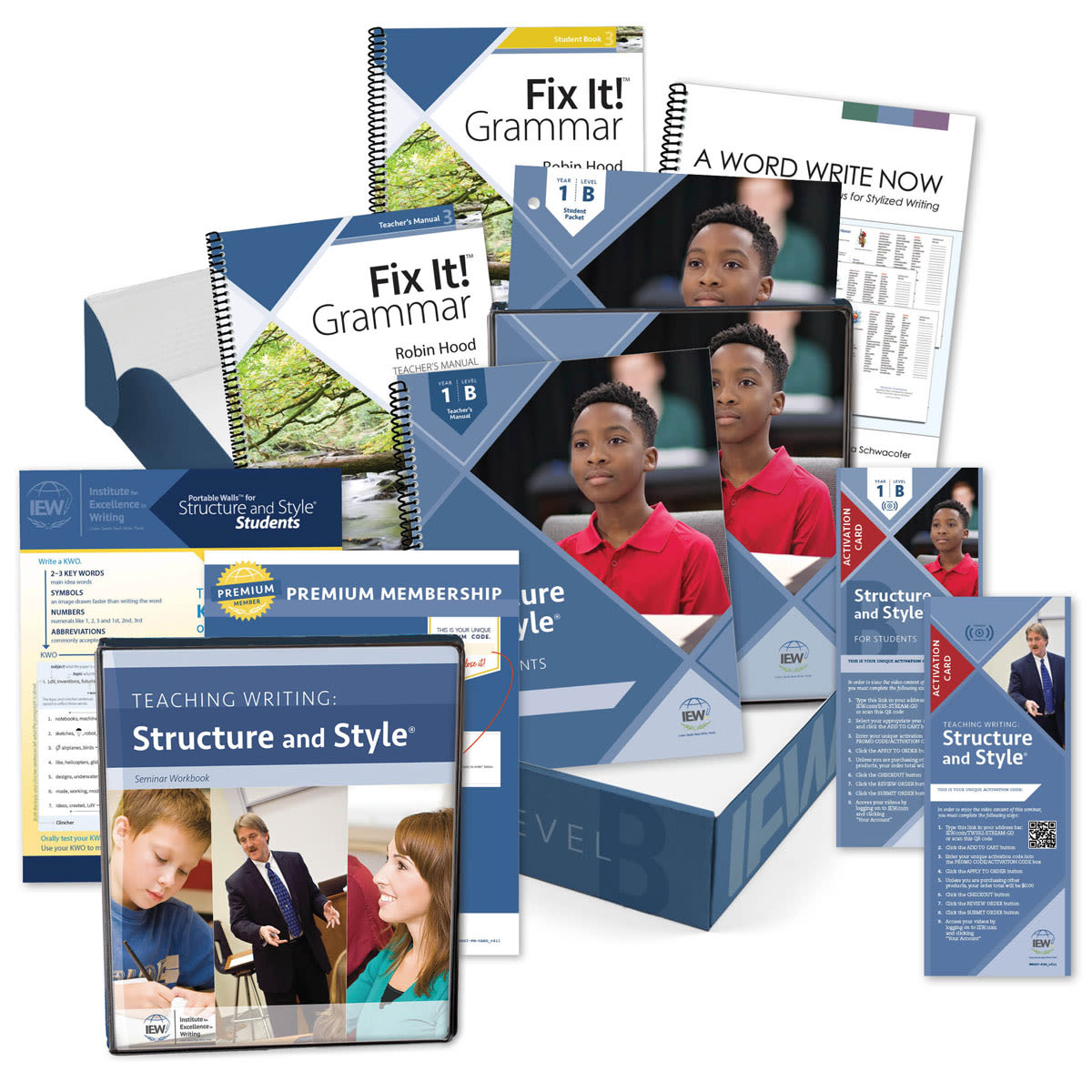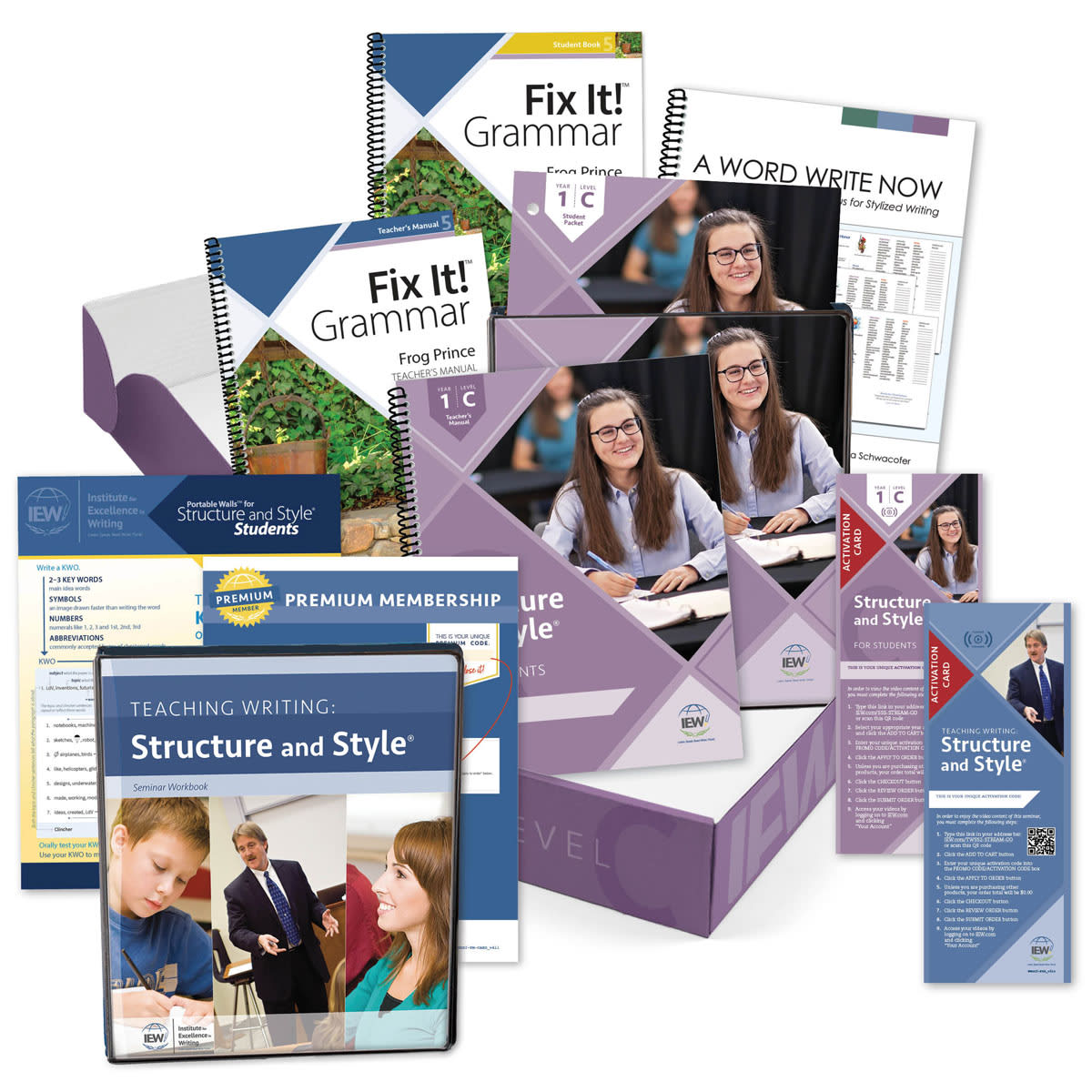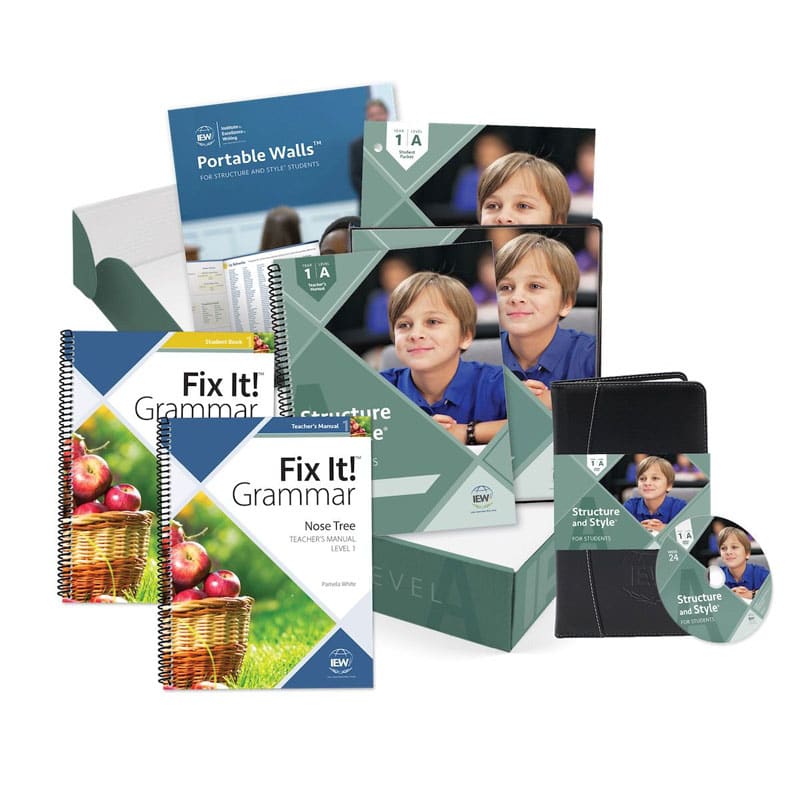Structure and Style® for Students (SSS) is a widely acclaimed program for teaching composition skills directly to students. Parents still need to be involved, but SSS courses do most of the work for them. These courses help homeschooling parents confidently teach children how to write—one of the most intimidating tasks in homeschooling. And SSS courses also appeal to students because they teach in incremental steps to make the writing process very manageable.
The SSS courses take the burden off of parents and teachers by having the creator of the course, Andrew Pudewa, teach students directly through videos. Pudewa is a fantastic teacher who often includes jokes, humor, and a bit of playacting as he presents lessons to classes of actual students. Both children and adults are likely to enjoy the lesson presentations.
SSS has six courses, with two courses each for three levels. Level A is for grades 3 through 6, Level B is for grades 6 through 9, and Level C is for grades 9 through 12. Each level presents students with comprehensive, grade-level-appropriate material.
SSS courses teach nine core units:
- Note Making and Outlines
- Writing from Notes
- Retelling Narrative Stories
- Summarizing a Reference
- Writing from Pictures
- Summarizing Multiple References
- Inventive Writing
- Formal Essay Models
- Formal Critique (book reports or basic literary analysis)
These nine units are presented gradually in Level A. The first seven are covered in the first-year course (SSS-1A), and the second year (SSS-2A) reviews the first seven units then teaches the last two. Level B teaches all nine units the first year (SSS-1B). The second year for Level B (SSS-2B) is spent applying and refining what students have learned and in learning to write responses to literature. Level C teaches the Structure and Style approach to high school students the first year. The second year of Level C also has students respond to literature, and it goes beyond that into a full study of literary analysis. While students who complete more than one level of SSS will repeat lessons on the core units, they will work at higher levels of difficulty with entirely different source material at each level.
SSS courses each include “forever” access to video instruction (either streamed or on DVDs), a printed teacher’s manual, and a student binder with a packet of pages. There are basic, basic plus, and premier packages for each of these courses. The basic package includes the videos, a teacher's manual, and a student binder. The basic plus package includes the above items plus a Fix It! Grammar course (a teacher and student set) and Portable Walls for Structure and Style Students (desktop dividers). The premier package adds to the basic plus package “forever” access to the Teaching Writing: Structure and Style (TWSS) seminar along with the binder and its contents for that seminar. Parents using an SSS course can work through the TWSS seminar to grasp the overall design of the program and its nine units much more quickly than they can with the SSS courses, but it is optional.
The streaming license never expires for an SSS course, so you need to buy only a binder with the student packet for each additional student in your family who will use each course.
In SSS, each week’s lesson features a two-part video lesson that will generally be viewed on two different days. Video lessons vary in length from about 25 to 50 minutes, although the average is about 30 minutes.
Pudewa frequently teaches vocabulary, grammar, usage, and spelling as part of his video instruction. While vocabulary is covered extensively within SSS, the coverage of grammar, usage, and spelling is not as thorough. Fix It! Grammar (FIX), from the same publisher, can be used to fill the gap. SSS lesson plans schedule in the optional use of one of the FIX courses so that using the two courses together provides fairly comprehensive coverage for language arts.
Each SSS basic plus or premier course will include a particular FIX course, and you cannot substitute a different course. For example, SSS-1A includes Fix It! Grammar: The Nose Tree (the first course in the series) in the basic plus and premier packages. Lesson plan information within SSS for FIX simply refers to the lesson for a particular week and day, so you can use any FIX course with an SSS course. If you want to use a different course than the one included in a basic plus or Premier package, just buy the basic option for SSS and purchase your FIX separately.
Even with a FIX course, you might need to work on advanced phonics with some students, and many students will need additional instruction on handwriting and spelling.
A literature suggestion in the lesson plan for each week recommends a fictional book such as Little House on the Prairie or Peter Pan to be used for reading aloud. The lengthier books are allotted two or more weeks in the schedule. There are no lesson activities for the literature suggestions, so you can easily choose different books if you wish.
The first course for each of the three SSS levels begins by teaching students how to write "key word outlines." In SSS-1A, students spend the first two weeks learning to create a key word outline, then they write their own version of each source text based on that outline. Students work first from one of Aesop’s fables and then from an informational text about giant saguaros. Even though the other levels also begin with key word outlines, the level of difficulty becomes more challenging with each level.
Source material for the key word outlines is included throughout each course, so parents do not have to find their own source texts. Source material includes both fiction and non-fiction. For instance, SSS-1A has a mixture of fables, tales, and informational pieces about topics such as reptiles, desert creatures, Antarctica, and African nomads.
Students gradually learn how to make their compositions more interesting with various types of "dress-ups." In the third week of SSS-1A, students begin to add dress-ups, starting with adverbs. Among the other dress-ups are quality adjectives, strong verbs, because clauses, who/which clauses, and adverb clauses. Assignments require students to write based on the specified source material and to use particular dress-ups, so they are highly structured in some ways. However, students still have room for creativity within the specified parameters, and Pudewa continually encourages them to come up with interesting and creative options. Lessons incrementally build composition skills so that students will have learned to write compositions of many different styles and lengths by the end of each course. Students generally seem to find that this combination of prescribed and creative content gives them security and confidence as they write. The carefully designed lessons almost guarantee success for students.
Students are also given practice in public speaking. Each time they write a key word outline, they are supposed to test it by retelling the story to another person based only upon their outline. Pudewa demonstrates for students the correct way to do this by looking at their outline, forming the sentence in their mind, then saying it loudly and clearly without referring to their outline.
Both the teacher and the student have lesson plans that make it easy to know what to do each day. In the teacher’s manuals, reduced images of the student pages are accompanied by teaching directions and suggestions. Lesson plans are set up for either four or five days per week, but there are suggestions for other schedules, including one for a group class that meets only once a week. SSS works especially well with a group of two or more students because there are frequent opportunities for students to work together or serve as the audience for one another.
Each SSS course takes 24 weeks to complete and includes an alternative 30-week plan, although each FIX course will take longer. You might select some source material of your own for students to work with for the remainder of the school year as they complete the rest of the FIX lessons. You might have noticed that SSS has six courses for grades three through twelve, which doesn't cover all ten years. The publisher recommends that students practice applying what they have learned by using resources such as their history-based writing lessons, interspersing those courses as they fit with a student's study of history.
Student compositions are graded only as complete or incomplete. Students will write rough drafts so that they can get feedback before creating their final drafts. Early in the course, students are told to “hire an editor.” They are to find someone who will help spot glaring errors, and they are supposed to arrange to trade for the editor’s time by pulling weeds, cleaning, or whatever else makes sense. The editor is given a letter that lets them know to under-edit rather than identify every error. Throughout the course, the goal is to encourage students and help them to be successful rather than to identify and rectify all of their errors.
The student binder has tabbed separators for various sections. The pages in the student packet gradually get sorted out into their appropriate sections. Some of these sections (e.g., stylistic techniques, banned words) will be used for reference, so the binder is used as more than just a place to store lesson plans and completed work.
Summary
Structure and Style for Students is popular because its structured process makes it both easy to teach and easy to learn. In addition, students can review and apply the basic strategies all the way through high school.










